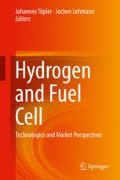Abstract
Using hydrogen as a fuel for the propulsion of large commercial passenger aircraft has the advantage that it contains about three times the energy content per weight compared to kerosene hydrogen. On the other hand the volume of hydrogen, even at cryogenic liquid state, is about four times the volume of kerosene. Additional tank weight for the storage of the cryogenic hydrogen partially balances the weight advantage again. Other applications in conjunction with fuel cell technology as energy converters achieve higher efficiencies compared to the today’s conventional technologies. Such configurations are currently applied as components for the propulsion of smaller electrically powered aircraft and electrical onboard generators at experimental level. In the case of using this technology as an onboard power generator on large commercial aircraft, it is possible to also use byproducts such as heat of reaction, process water and the low-oxygen exhaust air.
Access this chapter
Tax calculation will be finalised at checkout
Purchases are for personal use only
Abbreviations
- AC:
-
Alternating current
- ATA:
-
Air Transport Association
- APU:
-
Auxiliary power unit
- ATRU:
-
Auto transformer rectifier unit
- ATU:
-
Auto transformer unit
- CS:
-
Certification specification
- DARPA:
-
U.S. Defense Advanced Research Projects Agency
- DC:
-
Direct current
- ECS:
-
Environmental control system
- EDP:
-
Engine driven pump
- EHA:
-
Electro-hydraulic actuator
- EMA:
-
Electromechanical actuator
- EMP:
-
Engine-driven pump
- JAA:
-
Joint Aviation Authorities
- JAR:
-
Joint aviation requirements
- K.A.:
-
Not specified (in German: keine Angabe)
- MEA:
-
Membrane electrolyte assemble
- MEA:
-
More-electric-aircraft
- ODA:
-
Oxygen depleted air
- PEM:
-
Polymer electrolyte membrane or proton exchange membrane
- PTU:
-
Power transfer unit
- RAT:
-
Ram air turbine
- WAI:
-
Wing anti-ice
References
Smolinka, T., Frauenhofer, I.S.E.: Wasserstoff aus Elektrolyse – ein technologischer Vergleich. FVS Workshop (2007)
Hirscher, M.: Handbook of Hydrogen Storage. Wiley, Weinheim (2010)
Rau, S., Dynetek Europe GmbH: Deutscher Wasserstoff-Energietag, 12–14 Nov 2003 (Essen)
Ziemann, J., Airbus Operations GmbH: Potential Use of Hydrogen in Air Propulsion, EQHHPP, Phase III.0-3 Final Report, May 1998
Tupolev: Cryogenic Aircraft. (2012). http://www.tupolev.ru/English/Show.asp?SectionID=82
Westenberger, A., Airbus Operations GmbH: Liquid Hydrogen Fuelled Aircraft – System Analysis – CRYOPLANE, Final Technical Report, 24 Sept 2003
N2telligence GmbH: Broschüre 2012
Steinberger-Wilkins, R., Lehnert, W.: Innovations in Fuel Cell Technologies RSC, Royal Society of Chemistry, 1st edn., 18 Oct 2010
Schwarze, M.: Flugzeugvorentwurf Bi-Fuel-und wasserstoffbetriebener Kurzstrecken-Frachtflugzeuge, Hamburg/Stuttgart im Juli 2009
Daniel Brewer, G.: Hydrogen Aircraft Technology. CRC Press (1991). ISBN: 0-8493-5838-8
Brand, J., Sampath, S., Shum, F., Pratt & Whitney Canada, Bayt, R.L., United Technologies Research Center, Cohen, J., Pratt & Whitney: Potential Use of Hydrogen in Air Propulsion, AIAA 2003-2879, 17 July 2003
Seeckt, K.: Conceptual design and investigation of hydrogen-fueled regional freighter aircraft. Licentiate Thesis Stockholm, Sweden (2010)
Arendt, M.: Vergleich des Einflusses der Sekundärleistungsentnahme auf den spezifischen Kraftstoffverbrauch unangepaßter und angepaßter Triebwerke. Große Studienarbeit, TU Hamburg-Harburg, Arbeitsbereich Flugzeug-Systemtechnik, Hamburg, Juli 2005
Boeing Media Release, St. Louis, 16 Sept 2010
http://europa.eu/rapid/pressReleasesAction.do?reference=IP/12/792&format=HTML&aged=0&language=DE&guiLanguage=en, 04 Aug 2012
http://www.airliners.de/technik/forschungundentwicklung/wie-ein-taxibot-funktioniert/27627. Wie funktioniert ein Taxibot? Stand: 19 July 2012 – 18:31 UTC+1
http://www.dlr.de/dlr/desktopdefault.aspx/tabid-10204/296_read-931/, 30 July 2012
Breit, J., Szydlo-Moore, J.: The Boeing Company, Seattle, Washington, 98124–2207; Fuel cells for commercial transport airplanes needs and opportunities. AIAA 2007–1390; 45th AIAA aerospace sciences meeting and exhibit, 8–11 Jan 2007, Reno, Nevada
http://www.avinc.com/uas/stratospheric/global_observer/, 06 Aug 2012
Faubladier, F., Rambaud, D.: Aeroconseil, Soc Survey Report, European Aviation Safety Agency, Ref. EASA.2008/1
Chilenski, J.J.: Software development under DO-178B, Jan 2002 (Associate Technical Fellow, Airborne Software Engineering, Boeing Commercial Airplanes)
http://en.ruvsa.com/catalog/orion_hale/, 08 Aug 2012
http://www.aviationweek.com/, 29 July 12, “Inside Boeing’s Phantom Eye”, Posted by Graham Warwick 3:40 PM on Dec 22, 2010
Aeropack: http://www.hes.sg/products.html, 27 Jan 2013, 22:33 UTC+1
Horizon Hyfish: http://www.horizonfuelcell.com/hyfish.htm, 27 Jan 2013, 22:22 UTC+1
ICAO: International Standards and recommended Practices - Environmental Protection – Annex 16 to the Convention on international Civil Aviation, Volume II, Aircraft Engine Emissions, Second Edition – 20 Nov 2008 - Start- und Landezyklus (Landing and Takeoff Cycle, LTO) (1993)
Fink, R.: Untersuchungen zu LPP Flugtriebwerksbrennkammern unter erhöhtem Druck. Technische Universität München (2001)
Wiesner, W.: Die Brennstoffzelle, Institut für Landmaschinentechnik und Regenerative Energien
http://www.boeing.com/commercial/aeromagazine/articles/qtr_4_07/article_02_1.html, 03 Feb 2013
Honeywell, Produktbeschreibung, APU 131-9[A] Auxiliary Power Unit, April 2013
http://beodom.com/en/education/entries/peak-oil-the-energy-crisis-is-here-and-it-will-last, 27 Apr 2013, 18:50 UTC+2
OPEC Secretariat: World Oil Outlook 2011, Helferstorferstrasse 17, A-1010 Vienna. www.opec.org, ISBN: 978-3-9502722-2-2
Römelt, S., Cassidian, W.P.: MEA-Vortrag, eaa-Koloquium (2010)
European Aviation Safety Agency: Certification specifications and acceptable means of compliance for large aeroplanes – CS 25.1351(d) RAT Amendment 12; 13 July 2012
http://de.wikipedia.org/wiki/Elektroflugzeug, 27 Apr 2013, 21:46
http://www.langeaviation.com/htm/deutsch/produkte/antares_H3/antares_h3.html, 27 Apr 2013, 22:11 UTC+2
European Aviation Safety Agency 17 July 2008, R.F00801, Notice of Proposed Amendment (NPA) NO 200819
http://www.langeaviation.com/htm/english/products/antares_20e/faq.html, 30 Apr 2013, 16:20. UTC+1
http://www.dlr.de/dlr/desktopdefault.aspx/tabid-10204/296_read-731//year-all/#gallery/1448, 20 May 2013; 22:05 UTC+2
http://en.wikipedia.org/wiki/File:Pathfinder_solar_aircraft_over_Hawaii.jpg, 03 June 2013
Noll, T.E., NASA Langley Research Center, Brown, J.M., National Oceanic and Atmospheric Administration, Perez-Davis, M.E., NASA Glenn Research Center, Ishmael, S.D., NASA Dryden Flight Research Center, Tiffany, G.C., NASA Ames Research Center, Gaier, M., NASA Headquarters: Investigation of the Helios Prototype Aircraft, Mishap Volume I Mishap Report, Jan 2004. http://www.nasa.gov/pdf/64317main_helios.pdf, 07 June 2013, 12:19 UTC+1
Author information
Authors and Affiliations
Corresponding author
Editor information
Editors and Affiliations
Rights and permissions
Copyright information
© 2016 Springer-Verlag Berlin Heidelberg
About this chapter
Cite this chapter
Westenberger, A. (2016). Hydrogen and Fuel Cells: Mobile Application in Aviation. In: Töpler, J., Lehmann, J. (eds) Hydrogen and Fuel Cell. Springer, Berlin, Heidelberg. https://doi.org/10.1007/978-3-662-44972-1_5
Download citation
DOI: https://doi.org/10.1007/978-3-662-44972-1_5
Publisher Name: Springer, Berlin, Heidelberg
Print ISBN: 978-3-662-44971-4
Online ISBN: 978-3-662-44972-1
eBook Packages: EnergyEnergy (R0)

